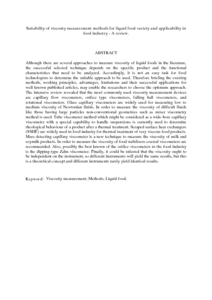Citation
K. A., Abbas and Mohammed, Abdulkarim Sabo and A. M., Saleh and M., Ebrahimian
(2010)
Suitability of viscosity measurement methods for liquid food variety and applicability in food industry - A review.
Journal of Food, Agriculture and Environment, 8 (3 & 4).
pp. 100-107.
ISSN 1459-0255
Abstract
Although there are several approaches to measure viscosity of liquid foods in the literature, the successful selected technique depends on the specific product and the functional characteristics that need to be analyzed. Accordingly, it is not an easy task for food technologists to determine the suitable approach to be used. Therefore briefing the existing methods, working principles, advantages, limitations and their successful applications for well known published articles, may enable the researchers to choose the optimum approach. The intensive review revealed that the most commonly used viscosity measurement devices are capillary flow viscometers, orifice type viscometers, falling ball viscometers, and rotational viscometers. Glass capillary viscometers are widely used for measuring low to medium viscosity of Newtonian fluids. In order to measure the viscosity of difficult fluids like those having large particles non-conventional geometries such as mixer viscometry method is used. Tube viscometer method which might be considered as a wide-bore capillary viscometer with a special capability to handle suspensions is currently used to determine rheological behaviour of a product after a thermal treatment. Scraped surface heat exchangers (SSHE) are widely used in food industry for thermal treatment of very viscous food products. Mass detecting capillary viscometer is a new technique to measure the viscosity of milk and soymilk products. In order to measure the viscosity of food stabilizers coaxial viscometers are recommended. Also, possibly the best known of the orifice viscometers in the food industry is the dipping-type Zahn viscometer. Finally, it could be inferred that the viscosity ought to be independent on the instrument, so different instruments will yield the same results, but this is a theoretical concept and different instruments rarely yield identical results.
Download File
![[img]](http://psasir.upm.edu.my/16891/1.hassmallThumbnailVersion/Suitability%20of%20viscosity%20measurement%20methods%20for%20liquid%20food%20variety%20and%20applicability%20in%20food%20industry.pdf)  Preview |
|
PDF (Abstract)
Suitability of viscosity measurement methods for liquid food variety and applicability in food industry.pdf
Download (84kB)
| Preview
|
|
Additional Metadata
Actions (login required)
 |
View Item |

